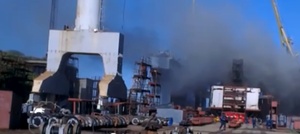
New Managing Director for Bellona Norway
The Board of the Bellona Foundation has appointed former Minister of Climate and the Environment Sveinung Rotevatn as Managing Director of Bellona No...
News

Publish date: September 18, 2013
Written by: Charles Digges
News
The fire was the second onboard a Russian nuclear-powered submarine that was in port for maintenance in less than two years.
The statements on injuries and damage to the sub from Naval and other officials represent a contradiction of official reports issued by the military on Monday.
That’s typical,” said Alexander Nikitin, chairman of the Environmental Rights Center Bellona and a former Russian naval captain. “For the Russian military, such delays in reporting are pretty much mandatory.”
In a report to President Vladimir Putin, Defense Minister Sergei Shoigu called for increased oversight of facilities where submarines are repaired, according to The Moscow Times.
Putin told Shoigu to present a report on how to avoid such accidents, telling him during a video conversation that, “This is not the first time this has happened in Russia,” in remarks reported by the paper.
Indeed, the Tomsk represents the fourth submarine fire since 2006, and the sixth major incident aboard a sub since the sinking of the Kursk submarine in 2000, when one two of the sub’s torpedoes exploded in their tubes during a training exercise.
The press service for the Investigative Committee, which probes major crimes in Russia, said in a statement Tuesday that it had opened a criminal probe into suspected abuse of authority over the fire on the Tomsk submarine in the Bolshoi Kamen shipyard in the Russian Far East. Nikitin said the Investigative Committee’s involvement was a routine matter.
The Investigative Committee’s statement said the Tomsk has “lost some of its functional characteristics” as a result of the fire, but offered no further information about damage to the submarine.
“The health of 15 servicemen was harmed and they are now receiving treatment in a military hospital,” the Investigative Committee’s statement said. It did not give further details on the nature of the injuries, where they were being treated and without divulging their names or ranks.
According to a statement (in Russian) on the website of the Unified Shipbuilding Corporation, the owner of the Bolshoi Kamen shipyard, the fire broke out in a ballast area of the submarine after a gas-powered saw was used to cut through a grate, setting an old rubber covering, cables and paint on fire.
The Investigative Committee declined to comment beyond its statement when phoned by Bellona on Wednesday.
Officials continue to say the submarine’s reactor was deactivated before the fire and posed no danger. This corresponds to information provided to Bellona by Grigory Pasko, a former Pacific Fleet Naval journalist, who said the Tomsk had been awaiting repairs at the Zvezda shipyard for five years, during which time the reactor would have been shut down.
The officials also said that all weapons aboard the Delta IV class submarine – including 24 missiles of the P-700 Granit variety, which are capable of delivering nuclear warheads from a distance of greater than 5,000 kilometers – were removed prior to the maintenance works that ended with the fire.
This has yet to be independently confirmed, although Nikitin said it would be routine for weaponry to be removed prior to maintenance work.
Reuters quoted Shoigu as telling Putin during their videoconference that the missiles had been removed from the Tomsk when it put in for repairs at Bolshoi Kamen in 2009, and repeated assertions from the Navy that there is not risk of a radioactive leak. This too seems to jibe with statements from former naval journalist Pasko.
But there is still room for speculation: The Navy insisted it had removed weapons from the Yekaterinburg submarine, which was set ablaze in 2011 by faulty welding works during maintenance at Ruslyakovo, near Murmansk.
Later investigations by Bellona shed question on the claim that the weapons have been removed prior to the maintenance and ensuing nine-hour blaze, whose flames were seen as far as 10 kilometers away and were reported to emergency services by ordinary citizens instead of the shipyard itself.
Russian deputy prime minister in charge of the defense industry Dmitry Rogozin later confirmed weaponry had been aboard the Yekaterinburg at the time of the fire.
The blaze aboard the Yekaterinburg injured 19.
Bellona General Director and nuclear physicist Nils Bøhmer called for far more independent oversight of submarine repairing facilities throughout Russia.
He said that after several nearly identical fires over the past seven years aboard Russian submarines undergoing repairs, “It is clear that the Russian Navy is not learning from its mistakes.”
He encouraged independent oversight consisting of other experts from within Russia’s civilian shipbuilding industry, such as nuclear vessel experts from the Russian nuclear icebreaker port of Murmansk.
“We need a body outside of the military establishment to help find out where the Russian Navy keeps erring,” he said.

The Board of the Bellona Foundation has appointed former Minister of Climate and the Environment Sveinung Rotevatn as Managing Director of Bellona No...

Økokrim, Norway’s authority for investigating and prosecuting economic and environmental crime, has imposed a record fine on Equinor following a comp...

Our op-ed originally appeared in The Moscow Times. For more than three decades, Russia has been burdened with the remains of the Soviet ...

The United Nation’s COP30 global climate negotiations in Belém, Brazil ended this weekend with a watered-down resolution that failed to halt deforest...